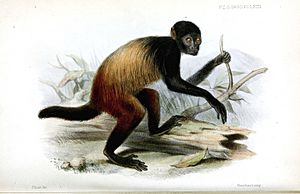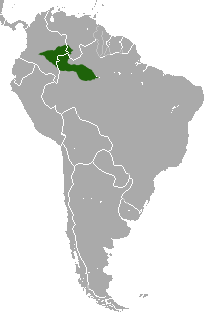Golden-backed uakari facts for kids
Quick facts for kids Golden-backed uakari |
|
|---|---|
 |
|
| C. m. ouakary | |
| Conservation status | |
| Scientific classification | |
| Genus: |
Cacajao
|
| Species: |
melanocephalus
|
 |
|
| species range | |
| Synonyms | |
|
Cacajao melanocephalus ouakary |
|
The golden-backed uakari (Cacajao melanocephalus) is a type of New World monkey. It belongs to the primate family Pitheciidae. This monkey lives in the Amazon Rainforest. You can find it in Brazil, Colombia, and Venezuela.
It has black fur covering most of its body. However, its belly, tail, and upper arms are reddish. The uakari also has a bald face. Its teeth are very special. They help it eat seeds and fruits with hard shells. The name "golden-backed uakari" was suggested by scientists in 2008.
Contents
About the Golden-backed Uakari
How Scientists Name Them
Scientists often study animals to understand them better. The golden-backed uakari was once called the black-headed uakari. For a while, scientists thought there were two types (subspecies) of this uakari.
But in 2008, new research changed things. Scientists found a new type of black uakari. They looked closely at the animals' bodies and their DNA. This helped them sort out the different uakari species.
The name "golden-backed uakari" then became the main name for this species. Another type, the black-backed uakari, became its own species called the Neblina uakari. A brand new species was also named the Aracá uakari.
What They Look Like
The golden-backed uakari has a black head with no hair on its face. Its lower legs and hands are also black. The soles of its hands and feet are black too. Its sides, tail, and upper arms have a reddish color.
These monkeys have a very short tail. It is not prehensile, meaning they cannot use it to grab things. They also have very special teeth.
Male and female uakaris are a bit different in size. This is called Sexual dimorphism. Females are usually a little smaller than males. Females weigh less than 3 kilograms (about 6.6 pounds). The whole species usually weighs between 2.5 and 3.7 kilograms (5.5 to 8.1 pounds).
Where They Live
Golden-backed uakaris live in the northwestern part of Brazil. They also live in southeastern Colombia and southwestern Venezuela. Their home is the Amazon Rainforest.
They especially like forests that flood during certain seasons. These are called igapos. Uakaris sometimes travel many kilometers. They do this to find their favorite fruits as the seasons change.
They have also been seen in other types of forests. These include drier forests, palm swamps, and rainforests.
What They Eat
These uakaris mostly eat seeds and fruits. But they also munch on leaves, soft plant parts, and insects. They have large canine teeth. These teeth help them crack open hard-shelled fruits to get to the seeds inside. Their incisor teeth can also break open husks.
They eat fruits from many different kinds of trees. Other monkeys in the same area usually don't eat hard fruits. This means there isn't much competition for food. However, some birds might compete for food with them.
When fruits are scarce, especially in the dry season, they eat more leaves. They also eat insects for protein. This happens when fruits are hard to find. Uakaris have even been seen raiding wasp nests for larvae. They also eat the eggs of river turtles!
How They Behave
Golden-backed uakaris usually live in groups of 5 to 40 monkeys. Sometimes, more than 100 uakaris might gather together. Monkeys within a smaller group stay close and interact often.
They are diurnal, meaning they are active during the day. They move around by walking and running on all fours. They can also climb and gallop. Leaping is their main way to travel. They can jump up to 10 meters (about 33 feet) in one leap! They only swim if they accidentally fall into the water.
When baby uakaris are born, they are quite small. They can be from 25% to 67% of their mother's body length. After birth, the babies stay with their mother for about a year and a half. The mother carries them on her back or front.
See also
 In Spanish: Mico Rabón para niños
In Spanish: Mico Rabón para niños


